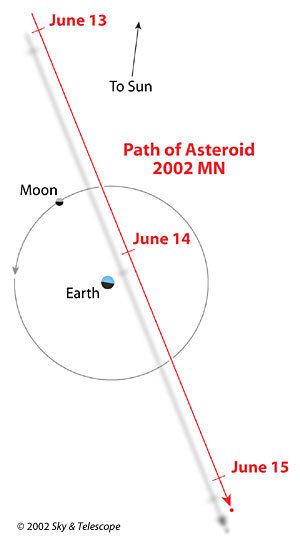Discovery date June 17, 2002 Aphelion 2.7189 AU (406.74 Gm) Eccentricity 0.49825 Discovered 17 June 2002 Argument of perihelion 131.479° | Semi-major axis 1.8147 AU (271.48 Gm) Orbital period 2.44 yr (892.90 d) Inclination 1.049° Mean anomaly 213.98° | |
 | ||
Similar (410777) 2009 FD, Solar System, (29075) 1950 DA, 2004 FH, 1972 Great Daylight Fireball | ||
Asteroid 2002 mn june 15 one of the closest flyby on record
2002 MN is the provisional name given to a 73-meter Apollo near-Earth asteroid that on June 14, 2002 missed the Earth by only 120,000 km (75,000 mi), about one third the distance to the Moon (0.3 LD). The close approach was second only to the Earth approach by the 10-meter asteroid 1994 XM1. 2002 MN was discovered on June 17, 2002 three days after closest approach. Its mass and relative velocity were in the same general range as the object ascribed to the Tunguska event of 1908, which leveled over 2,100 km2 (800 sq mi) of trees in Siberia. 2002 MN has an observation arc of 53 days with an uncertainty parameter of 6. There is a cumulative 1 in 50,000 chance that the asteroid could impact Earth sometime after 2100 and a 1 in 50,000 chance of impact on 16 June 2100.
